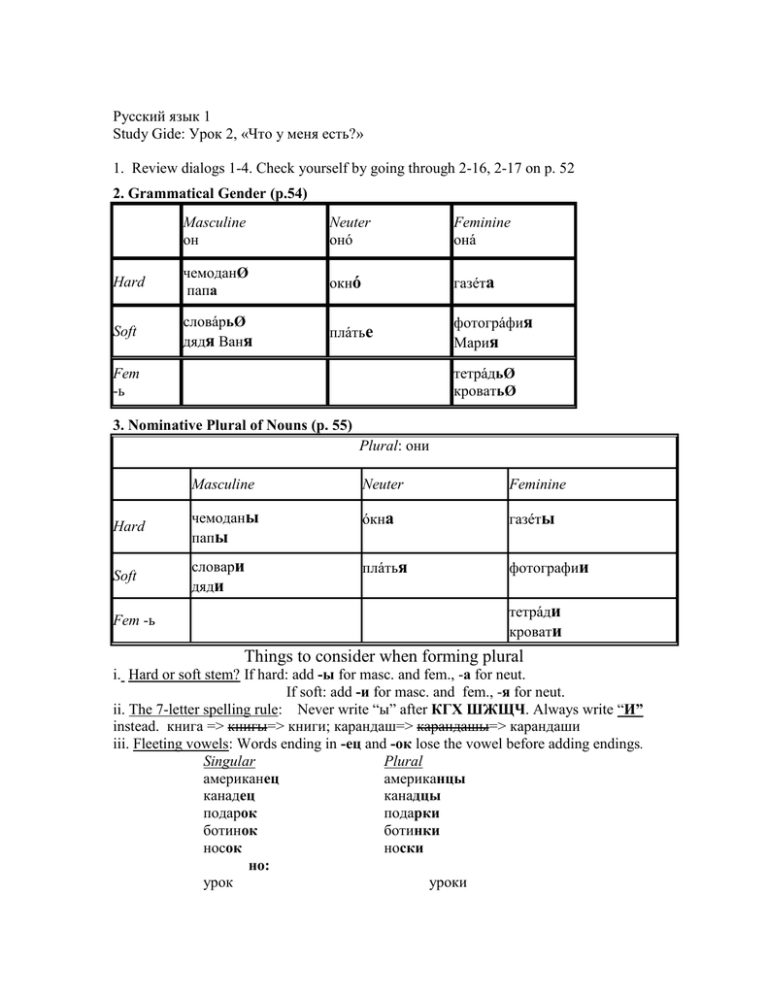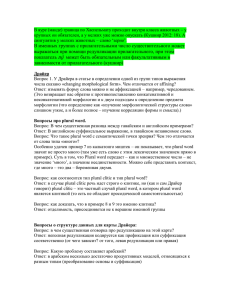Русский язык 1
реклама

Русский язык 1 Study Gide: Урок 2, «Что у меня есть?» 1. Review dialogs 1-4. Check yourself by going through 2-16, 2-17 on p. 52 2. Grammatical Gender (p.54) Masculine он Neuter онó Feminine онá Hard чемоданØ папа окнó газéта Soft словáрьØ дядя Ваня плáтье фотогрáфия Мария тетрáдьØ кроватьØ Fem -ь 3. Nominative Plural of Nouns (p. 55) Plural: они Masculine Neuter Feminine Hard чемоданы папы óкна газéты Soft словари дяди плáтья фотографии Fem -ь тетрáди кровати Things to consider when forming plural i. Hard or soft stem? If hard: add -ы for masc. and fem., -a for neut. If soft: add -и for masc. and fem., -я for neut. ii. The 7-letter spelling rule: Never write “ы” after КГХ ШЖЩЧ. Always write “И” instead. книга => книгы=> книги; карандаш=> карандашы=> карандаши iii. Fleeting vowels: Words ending in -ец and -ок lose the vowel before adding endings. Singular Plural американец американцы канадец канадцы подарок подарки ботинок ботинки носок носки но: урок уроки iv. Stress shift. словáрьсловари, письмóписьма, окнóóкна v. Irregular plurals. Some masculine nouns form their plural with the ending -a Singular Plural профессор профессорá дом домá свитер свитерá паспорт паспортá голос голосá цвет цветá vш. Indeclinable nouns: Words of foreign origin ending in -o, -и, у never change their form: Singular Plural радио радио пальто пальто такси такси кенгуру кенгуру 4. Indicating Having Something: у меня есть, у тебя есть, у вас есть (p.63) --У тебя/вас есть машина? --Да, у меня есть машига. // -Нет, у меня нет. 5. Possessive Pronouns (p.57) Masculine Neuter Feminine чей? чьё? чья? Plural (All genders) чьи? Я мой моё моя мои Ты твой твоё твоя твои Мы наш наше наша наши Вы ваш ваше ваша ваши он она они его её их (His, hers, theirs never change) 6. Adjectives (p.59) SOFT STEM “good” stem “trouble” stem HARD STEM Masculine Neuter Feminine Plural (All genders) stem stress нóвый нóвое нóвая нóвые end stress голубóй голубóе голубáя голубые большóй большóе большáя большие рýсский рýсское рýсская рýсские хорóший хорóшее хорóшая хорóшие синий послéдний синее послéднее синяя послéдняя синие послéдние 7 end stress 7 stem stress 5(+7) ADJECTIVE ENDINGS. THINGS TO CONSIDER A. HARD STEMS i. Stem stress vs. Ending stress. Hard-stem adjectives can be either stem-stressed (нОв-ый, мАленьк-ий, красИв-ый, хорОш-ий) or ending-stressed (a different ending will show only in masc.sg.: молод-Ой, больш-Ой, как-Ой, голуб-Ой). ii. What consonant does the stem end in? a “good” consonant (нОв-ый, бел-ый, голуб-Ой) or a “trouble” consonant К ГХ ШЖЩЧ Ц (больш-Ой, мАленьк-ий, хорОший). iii. Trouble Consonant Rules: iii-1 7-letter Rule: Never write “ы” after КГХ ШЖЩЧ Always write “И” instead. Alarm spots: Masc.Sg. in stem-stressed adjectives (хорОш-ий, мАленьк-ий) Nom.PL. all stems (хорОш-ие, мАленьк-ие, больш-Ие, плох-Ие, как-Ие) iii-2. 5-letter Rule: Never write unstressed “o” after ШЖЧЩ and Ц Always write “е” instead. Alarm spots: Neut. Sg. in stem-stressed adjectives (хорОш-ее) B. SOFT STEMS The only two soft-stem adjectives we are going to have for the time being are СИН-ИЙ and ПОСЛЕДН-ИЙ 7. What: что vs. какой (p.61) WHAT что What do you have in your suitcase? Что у вас в чемодане? Что это? какой a) 'what kind' b) 'what a' a) What suitcase is this? Какой это чемодан? b) What a big suitcase! Какой большой чемодан! When in English what is followed by a noun OR when it CAN be replaced with what kind of you can safely translate it as какой. 8. This is/These are vs. This X is…/ These Xs are… ЭТО vs. ЭТОТ/ЭТА/ЭТО/ЭТИ (p. 62) Этот журнал... This magazine is… Это журнал. This is a magazine Это письмо... This letter is… Это письмо. This is a letter. Эта газета... This newspaper is... Это газета. This is a paper. Эти очки... These glasses are ... Это очки. These are glasses. This newspaper is mine. Эта газета моя. This letter is scandalous. Это письмо скандальное. This is a scandalous book. Это скандальная книга. This book is dull. Эта книга неинтересная. 9. Oral/listening: Answering questions in writing and reciting one of the dialogs with a partner. 10. Numbers: 0-49
